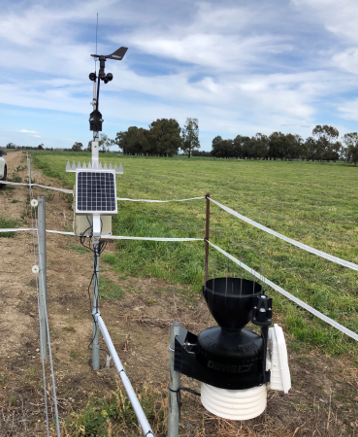Wednesday 24 April 2024
Weekly Irrigation Requirement$ Summary – Driving Water Productivity
Northern Victoria
This update provides ‘reference evapotranspiration’ (ETo) information to assist with improved irrigation scheduling for top yields and high water productivity.
Similar weather and irrigation scheduling information provided in this email that is updated daily for any Vic location, including an interactive irrigation spreadsheet, is now available on ExtensionAus.
Please note that this update is one day earlier than normal, on Wednesday rather than Thursday, due to the Anzac Day holiday.
This is my last official write-up of the “Weekly Irrigation Requirement$ Summary.” Thank-you for your support and interest over the last 9 years of the service. Future updates are in the capable hands of Amanda Gois Viana, a dynamic AgVic Irrigation Extension Officer based at Kerang.
In this update:
- Weekly irrigation requirements summary.
- Water commentary:
– Planning your 2024-25 water needs.
– Risk of spill 2024-25.
– sMDB water availability outlook.
– Using other water products. - Forewarned is forearmed:
– Forecast rain. Next 8 days. Next 4 weeks – Murrabit.
– Chance of at least 15mm beyond 8-days.
– Forecast maximum temperatures. Next 4 weeks – Murrabit. - Last week’s irrigation requirement.
- Next week’s irrigation requirement.
- Daily ETo and rainfall.
- Soil temperature.
- Seven-day forecast – wind speed, temp, humidity, rain, & ETo. Murrabit.
1. Weekly irrigation requirements – summary
- Dashboard estimate: The required pasture surface-irrigation interval (for a 40mm refill point) is 20 days based only on cumulative ETo for the past week (not including any rainfall), at Kyabram. See “Last Weeks ETo” table below.
- The plant water requirement (irrigation and rainfall) for our reference crop of pasture (ETo) for the past 7 days was 15mm, which is the same as the ‘previous’ week, and 1mm less than the long-term April weekly average, at Kyabram. See the table immediately below.
- Cumulative ETo for the next 7 days is forecast to be 16mm at Kyabram. See the tables below. Use the online ETo Tool for updates.
- The Bureau forecasts 0-5mm of rain for the next 8 days for much of the irrigated plains, at this stage. See the rainfall maps and the daily ETo and rainfall graphs below. Monitor BoM for updates.
‘Water requirement’ for our reference crop of pasture (ETo) at Kyabram*:

* See the tables and graphs below for ETo (and rainfall) at more locations.
** Rainfall is not included in these estimates. The figures presented are cumulative daily short crop reference evapotranspiration (ETo).
2. Water commentary
Planning your 2024-25 water needs
As the irrigation season draws to a close, now is a good time to consider your water needs for 2024-25 and beyond. Do you know if or how much water you will have left over at the end of this season, and if it will exceed the volume of your Low Reliability Water Shares (LRWS)? If you are on the Goulburn, or Campaspe system, remember that if you currently have water in the spillable account, remaining spillable water will return to your allocation account on 10 June. To find out how much water you have remaining (and how much you have in the spillable account), check out your Water Usage Report on WaterLine. Unused water at the end of the season is automatically carried over if it does not exceed your entitlement volume and if it is held in an allocation account linked to water shares.
Risk of spill 2024-25
The risk of spill on the Vic Murray, Goulburn and Campaspe is expected to be at least 70% at the start of July 2024 (as assessed on 15 Feb). This means there is an increased risk of losing at least some carryover water due to spill, particularly if it is carried over against High Reliability Water Shares (HRWS), rather than LRWS.
If you are a little uncertain about how carryover and spill work, the Vic Water Register Carryover Calculator tool allows you to test different scenarios for your unique circumstances.
sMDB water availability outlook
In terms of sMDB water availability next season, seasonal determinations close to 100% HRWS are expected by mid-August 2024 on the Vic Murray and Goulburn systems with average inflows. For LRWS seasonal determinations to occur, the Vic Murray and Goulburn systems need average or better inflow conditions
NSW Murray general security (GS) allocations are expected to reach 110% by 1 Nov 2024 with average inflows, and the maximum permissible carryover volume is estimated (50%GS, or 838GL).
For South Australian River Murray irrigators, the projected minimum opening allocation for the 2024-25 water year is 100%.
Using other water products
This season could be an opportune time to ‘dip your toe in the water’ with a water product you have never used before to better manage water price risk. Other than carrying over on your own LRWS (or HRWS!), other options to better secure water include parking on someone else’s LRWS, or on leased or purchased LRWS (or HRWS!). Forward contracting water, leasing or purchasing HRWS, or using the allocation market at the spot price, are other options.
The best water product mix will depend on your unique situation, goals, and attitude to risk. Talking to your partner, neighbour, trusted advisor, or water broker may help with decisions about how to best secure your future water needs.
3. Forewarned is forearmed
The Bureau (“BoM”) has a range of online ‘Forewarned is Forearmed’ tools that provide forecast rainfall and temperature beyond 8 days, including the chance of extremes, chance of 3-day totals, and chance of “at least” a nominated amount of rain. Some of these tools are shown further below.
Forecast rain – next 8 days
The Bureau forecast 0-5mm of rain for the next 8 days for much of the irrigated plains, at this stage. See the rainfall maps below.
Forecast rain – Wed 24 Apr (today) to Sat 27 Apr
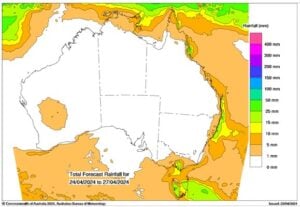 Source: BoM.
Source: BoM.
Forecast rain – Sun 28 Apr to Wed 1 May (next week)
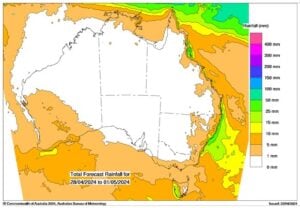 Source: BoM.
Source: BoM.
Forecast rain for Murrabit – next 4 weeks
Based on forecast weekly medians, the outlook for rainfall over each of the ‘next 4 weeks’ (graph below) at Murrabit is ‘dry’, at this stage – but some rain is still possible looking at the ‘box and whisker’ plots.
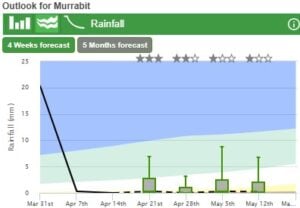
 Further detail.
Further detail.
To generate a similar graph to the one above for your location, click on the “Forewarned is Forearmed” link immediately below, then on the BoM page click on the location icon, enter your location, and select the ‘Rainfall climate summary’ graph icon. Source: Forewarned is Forearmed. BoM.
Chance of at least 15mm rainfall beyond 8-days
The Bureau forecast 0-10% chance of at least 15mm for 5 – 11 May (week ‘beyond 8 days’) for much of the irrigated plains, at this stage. See the graph below.
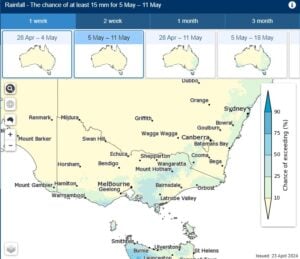 Source: Forewarned is Forearmed. BoM.
Source: Forewarned is Forearmed. BoM.
Forecast maximum temperatures
Based on the forecast weekly medians, the maximum temperature outlook over each of the ‘next 4 weeks’ is for a declining trend from 21oC – 19oC averages at Murrabit, at this stage – with some possible variation looking at the ‘box and whisker’ plots.
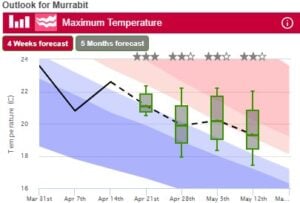
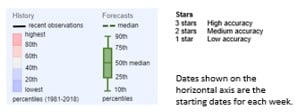 Source: Forewarned is Forearmed. BoM.
Source: Forewarned is Forearmed. BoM.
4. Last week’s reference evapotranspiration (ETo)+
Pasture Irrigation Requirement$
Weekly Totals – Wed 17 Apr – Tues 23 Apr

= This location is listed as a feature of interest and changes each week. ETo data for this location that is updated daily, and associated irrigation information, can be accessed on the Online ETo Tool.
The weather data used in this update is now sourced from BoM. Historic daily ETo and rainfall data is sourced from BoM’s gridded Australian Water Outlook service. Historical daily ETo and rainfall figures may change significantly over time, particularly in the first three days, because improvements are made to the dataset as more data is received by the BoM from different weather stations. Forecast daily ETo data is from BoM’s Gridded Evapotranspiration Products derived from the Australian Digital Forecast Database (ADFD), which is ‘fee for service’. Forecast rainfall is also from the ADFD. Please visit AgVic’s Oline ETo Tool for updated ETo and rainfall data for your location.
Tip: To convert mm to megalitres /ha, divide by 100. Eg. 50mm = 0.5ML /ha.
Important: The “required surface irrigation interval” shown in these tables is a ‘dashboard estimate’ and is calculated using cumulative ETo only over 7 days, and needs to be considered in conjunction with rainfall on your farm. This time of the year (Apr) for each 3mm of effective rain on your property, typically an extra day can be added to the “required surface irrigation interval” for pasture. Because rainfall can vary over short distances, please collect and use your own rainfall measurements. The rainfall figures in the tables are only a guide.
For more information about selecting an appropriate crop coefficient for your particular crop and its stage of development refer to this Tech Note What is evapotranspiration and how do I use it to schedule irrigations?, AgVic’s Online ETo Tool Interactive Spreadsheet, or this scientific booklet (FAO56) – Table 12, Chapter 6.
5. Next week’s forecast reference evapotranspiration (ETo)
Pasture Irrigation Requirement$¥
Weekly Totals – Wed 24 Apr to Tues 30 Apr
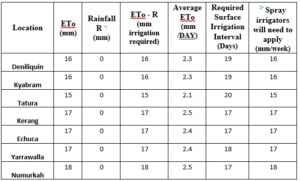
< Only daily rainfall events 2mm or greater are included in the above tables and in the ETo graphs below.
6. Daily evapotranspiration (ETo) and rainfall – last week & next week
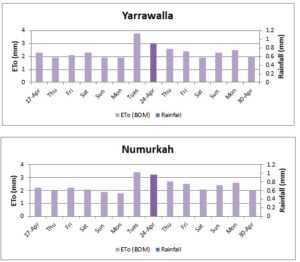
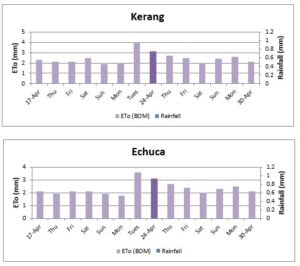
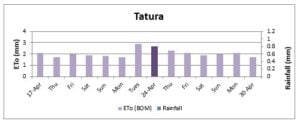
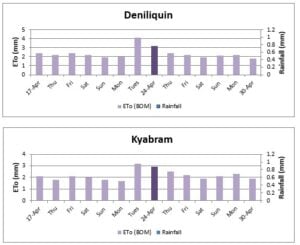
7. Soil temperature
The soil temperature measured by a capacitance probe at 9am today (Wed 24 Apr) under surface irrigated annual pasture at 10cm depth at Wee Wee Rup (near Leitchville) was 16oC, the same as this time last week (17 Apr), and the same as this time last year. See the graph below.
Soil temperature measured by a capacitance probe at 10cm depth under surface irrigated annual pasture at Wee Wee Rup near Leitchville
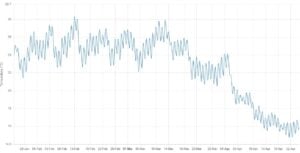
The soil temperature at the Tatura weather observation station at 10cm depth at 11.15am today (Wed 24 Apr) was 15oC.
8. Seven day forecast for Murrabit
SWAN system free daily email service for practically any location
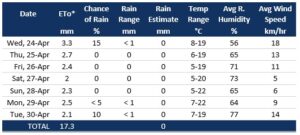
A 3-hourly breakdown of forecast weather variables for you location is provided on BoM’s MetEye service, including wind speed, wind direction, rainfall probabilities, temperature, likelihood of frost or thunderstorms, and more.
—————————————————————————————————————————————
The intention of this service is not for this information to be used in isolation when making decisions about irrigation scheduling. ETo data provides another handy tool in your irrigation ‘tool box’ and needs to be used in conjunction with other preferred scheduling methods and updated weather information.
Here’s a top offer! If you would like 7-day forecast ETo (and rainfall, temperature and wind) for any selected location/s emailed to you daily for free, please click here.
Similar weather and irrigation scheduling information provided in this email that is updated daily for any Vic location, including an interactive irrigation spreadsheet, is now available on ExtensionAus.
For more detail about using evapotranspiration data refer to this Agriculture Victoria Tech Note “What is evapotranspiration and how do I use it to schedule irrigations”, or this scientific booklet. Alternatively, irriSAT is an Australian web-based irrigation scheduling tool that uses satellite ‘vision’ to tailor irrigation scheduling for your crops. Or, IrriPasture or the SoilWater app are relatively simple and user-friendly tools that use regional weather-based measurements to assist with scheduling irrigations on your farm.
——————————————————————————–
+ Reference evapotranspiration (“ETo”). Refers to the evapotranspiration from an actively growing, well-watered, grass stand 120mm in height. Sourced from AgVic Online ETo Tool, which uses BoM AWO data. BoM AWO gridded daily historical ETo figures may change significantly over time, particularly in the first three days, because improvements are made to the dataset as more data is received by the BoM from different weather stations.
~ “Rainfall R.” Historical rainfall data is sourced from BoM AWO. BoM AWO gridded daily historical rainfall figures may change significantly over time, particularly in the first three days, because improvements are made to the dataset as more data is received by the BoM from different weather stations. Where a rainfall event is less than 2mm it is usually not ‘effective’ in terms of adding to the soil moisture reserve (because it is unlikely to penetrate through the crop canopy) and is unlikely to be listed in the tables or graphs. Also be aware that any rain in excess of that which fills the soil root profile (run-off or deep percolation) is also not ‘effective’ from an irrigation perspective. Because rainfall can vary over short distances, you are encouraged to collect and use your own rainfall figures for your farm.
x “Dairy pasture crop coefficient.” A crop coefficient refers to your crops relative water use potential. For crops other than pasture refer to this Tech Note for discussion of an appropriate crop coefficient “What is evapotranspiration and how do I use it to schedule irrigations?” Alternatively, you can use AgVic’s Online ETo Tool Interactive Spreadsheet which provides guidance on which crop coefficient to use for your particular crop and it’s stage of development. Crop coefficients are also provided for a range of crops in this scientific booklet – Table 12, Chapter 6.
^ The “Average (daily) ETo” is simply calculated by dividing the total weekly cumulative ETo by 7 days.
@ To calculate the “Required surface irrigation interval” it is assumed there is 40mm of ‘readily available water’ in the pasture root zone. eg. Required surface irrigation interval = 40mm ÷ average (daily) ETo, plus 1 day to allow for excess water to drain away following a surface irrigation event. The “Required surface irrigation interval” is really only a dashboard estimate based only on cumulative ETo over the recent 7 days, to suit the purpose of a weekly update. For more accurate irrigation scheduling particularly in spring and autumn, the cumulative deficit (ETo – R) since the last irrigation usually needs to be calculated over a period longer than 7 days and the irrigation timed when the readily available water (40mm in this case) is depleted.
> “Spray irrigators need/ed to apply.” This figure is based only on evapotranspiration minus rainfall (“ETo – R”) for the given week and assumes excellent accuracy in terms of mm water applied, spray uniformity, and application efficiency. Typically spray uniformity will not be 100% and extra water will need to be applied to best meet plant needs. The “Spray irrigators need/ed to apply” figure given in the table also assumes the rainfall is effective and contributes equivalently to the soil moisture reserve, which may not be the case. In practice, the moisture deficit (or reserve) carried into the season also needs to be considered to ensure there is adequate soil moisture for maximum plant growth and to avoid a “green drought.” It is best to use rainfall measurements collected on your property. Typically, with pressurised irrigation systems, irrigations occur more regularly than with surface irrigation to optimise plant growth. Due to the cumulative error involved with using ETo data over a period, it is important that other scheduling methods are used in conjunction with ETo data for spray irrigation systems.
¥ “Next weeks forecast reference evapotranspiration – pasture irrigation requirement.” Forecast ETo and rainfall data is sourced from AgVic’s online ETo tool, which uses forecast daily ETo data from BoM’s Gridded Evapotranspiration Products derived from the Australian Digital Forecast Database (ADFD). Forecast rainfall is also from BoM’s ADFD. If you would like 7-day forecast ETo (and rainfall, temperature and wind) for any selected location/s emailed to you daily, please click here.
This publication is provided solely for information purposes and no representation or warranty is made as to its quality, accuracy, completeness, suitability, or fitness for any particular purpose. You should make your own enquiries as to its appropriateness and suitability for your particular circumstances. The State of Victoria as represented by its Department Energy, Environment and Climate Change accepts no duty of care and disclaims all liability in relation to use of this publication.
_____________________________________________________________________________________________________

